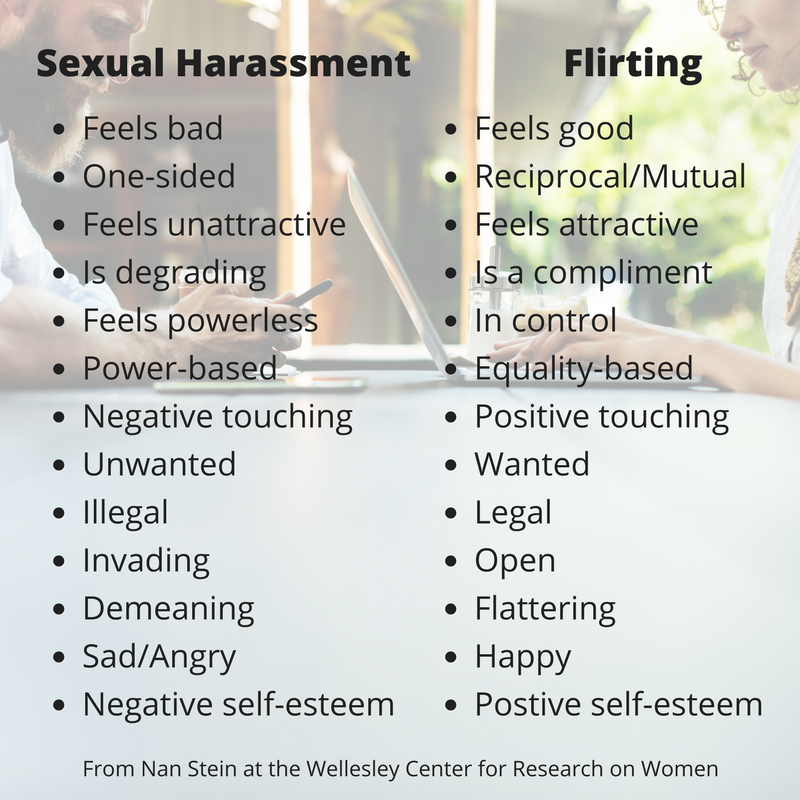Weinsteingate and Sexual Harassment: What Now?


It’s almost impossible to have missed the #MeToo conversations happening on social media last month. It came along with a myriad of allegations of sexual abuse from far too many women and the abuse of power by Harvey Weinstein, the movie mogul. Now, this past week allegations have been made against Kevin Spacey by an actor about inappropriate sexual behavior when he was a minor at the time.
As of this posting, there are also allegations against Dustin Hoffman, Richard Dreyfus, and a growing list of others. As I grew up around the entertainment industry, I find this all so incredibly sad. It’s not that I wasn’t aware that this goes on, but as all of these reports are coming out, I now realize that I had no idea of just how widespread the problem really is.
The Good News
This has caused a slew of women, and a few men, to come forward with their stories of sexual misconduct within the television and movie industry as well as in politics and media.
This is an interesting time in our history to be sure. Empowering many women. Painful for others, women and men who are not in the headlines but have also been subjected to abuse, each revelation now brings up uncomfortable memories for them as well.
But overall, the very good news and the biggest takeaway is awareness for both men and women that reports of sexual misconduct or assault should not be ignored.
The courage these people are exhibiting by coming forward allows us all to have a conversation that had previously been dismissed and oftentimes swept under a rug. Now it’s becoming safer to have the conversation. As a therapist, I’m very pleased with this development.
How Does This Relate To You?
But let’s talk about how this relates to you. If you’re a woman, clearly, a vast majority of you have been assaulted or harassed in the past.
If you’re a man, you may also have had a similar experience or maybe this is an opportunity for you to learn more appropriate behavior. Although talked about less, young boys have also been the targets of predators as well, by men and women, with the predominance of molestations and rapes being perpetrated by males.
Let’s take a look at what we are learning in the era of Weinsteingate.
What do we mean when we’re talking about what is and what isn’t sexual harassment.
What is Sexual Harassment?
Let’s be as clear as possible as to just what sexual harassment is. Title VII of the Civil Rights Act of 1964 defines sexual harrassment in the workplace as follows:
Unwelcome sexual advances requests for sexual favors, and other, verbal or physical conduct of a sexual nature constitutes sexual harassment when this conduct explicitly or implicitly affects an individual’s employment, unreasonably interferes with an individual’s work performance, or creates an intimidating, hostile, or offensive work environment.
Of course, sexual harassment occurs in all areas of life, not just in the workplace. It can happen virtually anywhere, anytime, between sexes, within sexes, and is perpetrated against adults, teenagers, and children.
Examples of Sexual Harassment
Margaret Langelan in Back Off! How To Confront And Stop Sexual Harassment and Harassers compiled the following examples of sexual harassment.
Note: This list has been slightly expanded to include female and male gender, references to both gender’s body parts, and to include factors such as the impact of social media:
➢ Leering
➢ Wolf whistles
➢ Sexual innuendo
➢ Unwanted comments about a person’s body
➢ “Accidentally” or intentionally brushing sexual parts of the body
➢ Lewd and threatening notes and letters
➢ Tales of sexual exploitation
➢ Graphic descriptions of pornography
➢ Pressure for dates or to hook up
➢ Unwelcome touching and hugging
➢ Grabbing breasts, buttocks, or penises
➢ Sabotaging women’s or men’s work
➢ Demanding “Hey baby – or hey guy – give me a smile”
➢ Inappropriate invitations (e.g. hot tub)
➢ Sexist jokes and cartoons
➢ Exaggerated, mocking “courtesy” in a condescending manner
➢ Hostile put-downs of women or men

➢ Public humiliation
➢ Obscene phone calls
➢ Displaying pornography in the workplace
➢ Insisting or even just suggesting that workers wear revealing clothes (emphasis added)
➢ Pressing or rubbing up against the victim
➢ Sexual assault
➢ Soliciting sexual services
➢ Stalking
➢ Invading a person’s space, such as leaning over them at their workstation
➢ Indecent exposure
➢ Secretly taking pictures of someone
➢ Cyberbullying through social media
This list of sexually harassing behaviors should be obvious. But, are there any other ways to help us figure out what is wanted or unwanted behaviors? Let’s look at flirting and how it can be perceived to give you some additional ideas to consider.
A Checklist
Clients, friends, family, and colleagues, and especially dating singles, ask me all the time about what is or isn’t appropriate, wanted, or desired when it comes to dating/hooking up and flirting in general.
Many would like some guidelines. Gratefully, we don’t need to reinvent the wheel here. That’s been done for us!
It turns out that Nan Stein, from the Wellesley Center for Research on Women, developed the following checklist to help everyone determine whether the behavior is normal flirting or sexual harassment. It’s simply based on what does or doesn’t feel good and what is or isn’t wanted.
It’s Not About Sex – It’s About Power
From Harvey Weinstein to Bill O’Reilly, it’s been less about sex and more about power. In so many of these sexual harassment cases, it’s the exchange of sexual favors/inappropriate behavior for a promise (or even a hint) of career advancement or favor.
It’s this part that makes my (and many others) stomach turn; the perpetrator gets off twice – both from sexual gratification but also holding advancement or favor above the victim.
For the victim, it’s another level of shame that keeps them silent and afraid. Meanwhile, the harasser walks away without the consequences of either action. It’s gross and immoral.
See Something – Say Something
If you see something inappropriate, let someone know. If you see a person being touched or confronted inappropriately, let them know that you can stand with them if they want to go to the authorities or a person in charge. If that feels too bold or unsafe to you, you can go to someone in an authority position and report what you saw. You don’t know if this is a repeated pattern, and you could stop it from happening to others with your information.
If you hear something inappropriate, like catcalls, do the same thing. Report it. If it is by a construction site, take a picture of the workers and the company name on the signs or sides of trucks. Call the company and let them know what happened. Most places no longer tolerate that kind of behavior from their workers.
Name It
If you are being harassed, let the perpetrator know that their actions are harassment. Describe their behaviors. Whatever they have done. Say it out loud. Name it and ask them to stop.
Be straightforward with your communication without excusing their behaviors (or yours). Don’t insult, joke around or threaten them in any way. Just be direct. Don’t respond to their comebacks, excuses or diversions. Stay firm.
This holds the harasser accountable for their behavior. It may have them think twice.
If his or her behavior continues, escalate it to someone in charge both verbally and documented via email (or pictures if appropriate). Inquire with other colleagues or acquaintances to discover if this is an isolated or patterned occurrence.
Talk It Out
Get into conversations with both men and women and talk about your experiences. Share how these kinds of situations have happened to you, how they made you feel, what you’ve learned, and what you would have done differently.
Encourage your women friends and family to speak out more.
Ask your guy friends if they feel like they have ever intentionally or unintentionally created this kind of sexually charged scenario. What do they now see as a result of this coming out into the open?
While some of these conversations may be uncomfortable, it’s a great place to explore and keep this conversation alive. With more open dialogue, the topic of sexual harassment gets to be more out in the open and not hidden in the shadows.
Ask for help
If you are experiencing feelings of shame, embarrassment, fear or anger as a result of a prior assault or harassment situation, seek help. It’s important to get the support you need to move through these feelings and take action if needed.
In order for the gravitas of Weinsteingate & #MeToo to stick and not fade away, it’s up to all of us to keep this conversation alive by speaking up, sharing our experiences, and supporting others’ courage as they step forward.
As always, if you need additional support in your own journey and not sure of what to do, I may be a resource for you. I have heard the incredibly sad stories of several who have been sexually harassed, bullied, and intimidated. You can recover from this. If you find yourself in that situation, or perhaps know of someone else who is, you are welcome to contact me for a free 15-minute phone consultation.


















The Wisdom & Art of Flirting
[…] sometimes it actually is fun and serious! Flirting dances along appropriate and non-invasive signaling of attraction and the possibility of something more. Either way, it’s […]
Bullying on Social Media (and Other Places): Tips to Lessen or Even Eliminate the Impact
[…] Sexual bullying often starts with crude name calling and inappropriate comments or gestures about another’s appearance, and in extreme cases, leading to inappropriate touching and even sexual assault. It is most often girls who are the victim; however, girls and boys are both guilty of being sexual bullies. […]